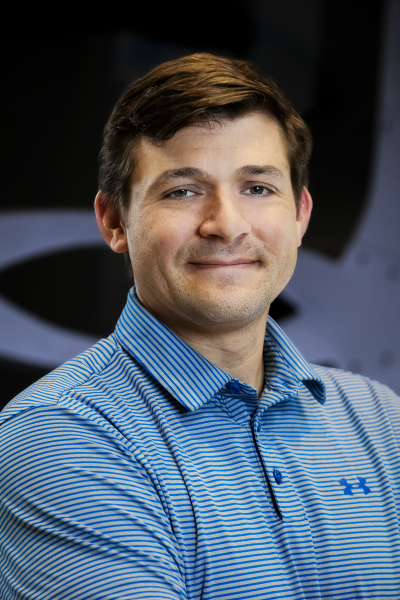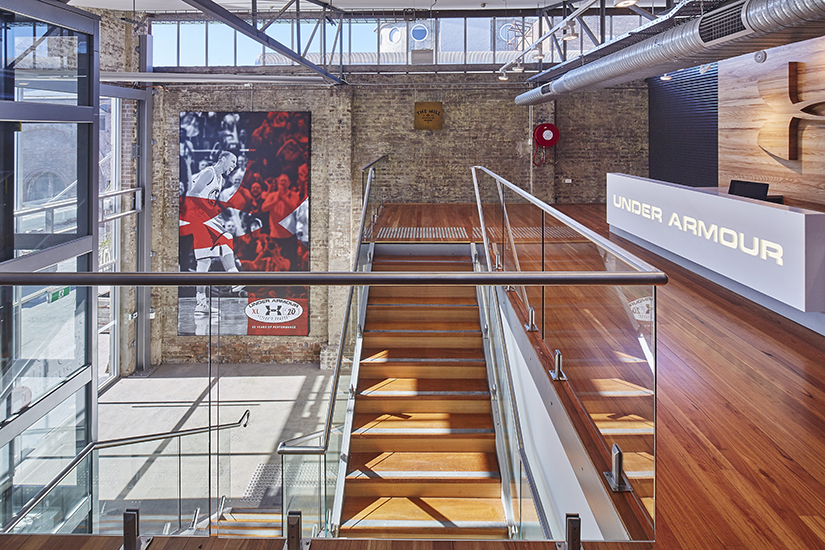For the first 11 years of his career, Scott Gassen worked for the Whiting-Turner Contracting Company. While there, he was encouraged to grow and explore his interest in Building Information Modeling (BIM) and sustainable design and construction practices. He also “learned a tremendous amount about the business of real estate and how it influences culture in multiple industries,” he says. “It was a strong foundation for the transition to corporate real estate. We would have to maintain the morale of a job site with 400 workers and think about how to inspire them.”
Today, Gassen brings his business expertise to bear on the corporate facilities of Under Armour, where he serves as director of project delivery. His approach to building and maintaining the company’s global footprint is grounded in learning as much as he can about the needs of his teammates and using the built environment to help them succeed.

This approach to real estate as an enabler of success is directly in line with the Under Armour brand. Founded in 1996, the company produces apparel, footwear, and accessories designed to help athletes achieve their peak performance. “We look at our buildings like another Under Armour product,” Gassen says. “What can we incorporate into the building that can provide even the slightest edge?”
Right now, the elements producing that edge are at the intersection of culture, place-making, and technology. Gassen views corporate real estate as a strategic support function for Under Armour and bases his decisions on the needs and input of others, who are part of the Under Armour team. He works closely with IT to determine how technological systems within a building can help facilitate business goals and relieve friction points that would otherwise slow down the progress of Under Armour’s employees.
When soliciting feedback, Gassen asks others not only what they need but why they need it. “We get interesting and compelling information that helps us consider how culture, space, and technology harmonize with each other,” Gassen says.
In turn, his team’s work embodies Under Armour’s vision of inspiring consumers with performance solutions they never knew they needed but can’t imagine living without. “Real estate creates a backdrop for our teammates to execute the mission and vision of the company,” Gassen says.
Gassen describes the various buildings on the Under Armour campus as an interconnected network. The campus has grown organically over the years, and as Under Armour continues to grow, his real estate strategy is aimed at increasing and enhancing connectedness among teammates. “We have studied spatial relationships quite extensively, and in every renovation we do, we think about how to interconnect spaces to build on that network,” Gassen says.
In terms of design, Gassen focuses on functionality, and he prioritizes wayfinding and clear navigation to ensure connectivity. Although his formal education in civil engineering draws on quantitative analysis, he is quick to tout the value of qualitative design choices. He believes Under Armour’s corporate structures should convey a consistency but also reflect their local cultures. Natural light is a particularly important characteristic. While its effects may not be quantifiable, natural light simply improves the way Under Armour employees experience their environment. The same goes for adaptive reuses of existing buildings and elements such as green walls. At first glance, they may seem unnecessary, but by exemplifying sustainability, creativity, and uniqueness, they underscore Under Armour’s values in a special way.
When Gassen joined Under Armour in 2014 to lead project delivery, the role was a new one on the corporate real estate team. One of the things he has enjoyed most is the opportunity to effectively apply his construction background to corporate real estate. “Learning laterally about leasing, development, facilities, and operations—incorporated with a deeper understanding of design—started to set the framework for future goals,” he says.
Gassen’s goals are rooted in the idea that real estate needs to evolve alongside societal and economic trends to best position the Under Armour team for present and future growth. There is no fear of implementing new strategies and altering them as needed. “We might deploy something different and unique to Under Armour,” Gassen says. “Not because of a trending real estate or design idea but because we listened and partnered with our teammates. Then, we measure it and make sure it’s working. If not, we adjust it. This creates a learning environment and organic partnerships.”

Gassen interacts with various Under Armour teammates across the world and knows this is an opportunity to leverage knowledge from other cultures. “I’m able to be the conduit that relays pieces of information that might not have found their way back through traditional channels,” he says.
Ultimately, Gassen knows it all comes together at the team level. From designer to laborer to end user, he understands the inner workings of every role in getting to any project’s end goal. As he works to maintain his real estate strategy in the face of new construction and delivery challenges, he remains grounded in the day-to-day efforts of his team and is the first to champion their achievements in overcoming adversity and adapting to change. He knows it is not simply about building a bigger campus for the sake of building. “Little moments along the journey can be major accomplishments in navigating through the complexities of any project,” he says. “Getting things to work together in real estate for a tremendous outcome creates multiple small moments that register the most with me as they all cumulate into the larger vision.”
***
DPR Construction (DPR) is a forward-thinking national general contractor and construction manager specializing in technically complex and sustainable projects for the healthcare, advanced technology/mission-critical, life sciences, higher education, and commercial markets. Founded in 1990, DPR is a privately held, employee-owned company that has grown into a multibillion-dollar organization with offices around the country.


